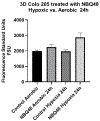Novel NBQ-48 as marker of hypoxic cells in 2D and 3D colon cancer cells
- PMID: 34765722
- PMCID: PMC8580369
- DOI: 10.15406/jcpcr.2020.11.00417
Novel NBQ-48 as marker of hypoxic cells in 2D and 3D colon cancer cells
Abstract
This study presents the applicability of a novel nitro-substituted heterocyclic compound NBQ48, member of the family of compounds identified as 3 nitrobenzazolo[3, 2-a] quinolinium chloride salts (NBQS) as a screening tool to identify hypoxic tumor cells. The applicability was tested on COLO 205 colon cancer cells 2D and 3D cultures treated with NBQ48 to assess the formation of a bio-reduction fluorescent metabolite under hypoxic conditions in contrast, to those under aerobic environment. Hypoxic environment was created applying a controlled hypoxic gas chamber. Prior to testing the applicability of NBQ48 as a hypoxic fluorescent marker, cytotoxic studies where performed to identify a low-toxicity dose at 24 hours under aerobic and hypoxic environments that would allow the bio-reduction process with little toxicity. The differences in fluorescence emission after treatment was measured by fluorometer and fluorescence microscopy. Results indicated that cell treatments up to 24 hours with NBQ48 under aerobic environment did not reach an IC50 dose in COLO205 cells, however under hypoxic environment the IC50 reached at 100μM. The significant fluorescence increment after 24 and 48 hrs in 2D and 3D cultures treated with NBQ48 (75uM) at hypoxic in contrast to aerobic environments clearly demonstrated the need of a low oxygen content for the bio-reduction of the parent NBQ48. This study confirms the applicability of NBQ48 as markers for hypoxia in metabolically active 2D and 3D cultures. This hydrophilic hypoxic marker could additionally aid researchers in testing hypoxia activated pro-drugs for therapeutic applications in cancer as well as on other diseases where cellular hypoxia is a significant risk factor.
Keywords: 3D cultures; NBQ quinolinium salt; colon cancer; fluorescent marker; hypoxia.
Conflict of interest statement
Conflicts of interest Authors declare no conflict of interest.
Figures







References
-
- World Health Organization. What causes Cancer? 2014.
-
- National Institute of Health. What is Cancer? 2015.
Grants and funding
LinkOut - more resources
Full Text Sources
